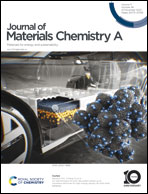Core–shell InN/PM6 Z-scheme heterojunction photoanodes for efficient and stable photoelectrochemical water splitting†
Abstract
Conjugated organic polymers (COPs), such as PM6, with attractive strong visible light absorption and good solution processability have been adopted as photocatalysts for building heterojunctions with InN nanorods for photoelectrochemical (PEC) water oxidation for the first time. Compared with the pure InN system, the PM6 photosensitive layer can effectively inhibit the severe charge recombination on the surface of the nanorod, and improve the kinetics of the oxygen evolution reaction (OER). In addition, the constructed Z-scheme heterojunction can consume the photogenerated holes from PM6 in a rapid and timely manner, thus improving the stability of the photoelectrode. Compared with the bare InN nanorods (0.12 mA cm−2), the improved photoanodes exhibit a significantly enhanced photocurrent density of 4.82 mA cm−2 at 1.45 V vs. RHE, respectively. Moreover, the current density of the photoanode protected by NiFe layered double hydroxide (LDH) can maintain approximately 80% of its initial value after continuous illumination in pH 13 electrolyte for 1 hour, indicating its long-term photochemical stability, which is the optimum value of the reported InN-based photoanodes. This means that InN-based photoanodes can achieve long-term stable PEC water splitting in a wide alkaline pH range, which can be directly used for PEC seawater splitting, eliminating the high cost and cumbersome process of seawater desalination. This work provides a promising method to construct group-III nitride-based photoanodes for high-performance PEC seawater splitting.



 Please wait while we load your content...
Please wait while we load your content...